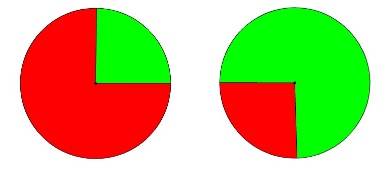Or search by topic
Number and algebra
Geometry and measure
Probability and statistics
Working mathematically
Advanced mathematics
For younger learners
Turning



Well, let's have a look at doing some simple turning.
To have a go at this task, you'll first need to make this 'interactivity' out of two differently-coloured discs of thick paper or card. Cut a slit into each from the edge to the centre in a straight line. Overlap the two slots and turn them to link the two discs together:

This YouTube Video shows how to make a similar thing with paper plates.
Can you turn your discs to show what:
a) a book being opened looks like from above?
b) turning a volume knob on your music player looks like?
c) a bicycle wheel looks like when going along?
d) a door would look like from above as it's being opened?
e) what a hamster wheel looks like when the hamster's running inside it?
Describe and then show some other things that you do or have seen, that turn in this way.
You can also have challenges that are just to do with the picture you see, for example, can you make the turning shape appear on the other side?

Can you make the red part twice the size of the green?
You may also like
Biscuit Decorations
Andrew decorated 20 biscuits to take to a party. He lined them up and put icing on every second biscuit and different decorations on other biscuits. How many biscuits weren't decorated?

